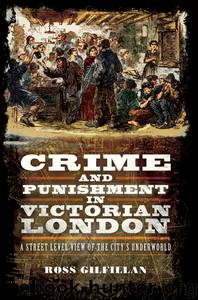Crime and Punishment in Victorian London by Ross Gilfillan

Author:Ross Gilfillan
Language: eng
Format: epub
Tags: HISTORY / Modern / 19th Century
ISBN: 9781473834729
Publisher: Pen and Sword
Published: 2014-03-02T16:00:00+00:00
The prison ship Defence and convict hospital ship Unite. The hulks were a stop-gap measure that lasted 80 years.
The Warrior prison hulk with the Sulphur behind. The lines of washing hanging from the masts clearly show the purpose of this ship.
A bird’s eye view of Coldbath Fields Prison.
CHAPTER 4
Murder and Mayhem
Panic on the streets of Victorian London
In September, 1850, a gentleman on his way home cuts through Regent’s Park at midnight and is joined by two young men heading in the same direction. The gent is making small talk – perhaps he is tipsy or nervous about his unexpected company – when the men attack him. His mouth is covered with a wad of material and his head is gripped in an armlock while the men rifle his pockets. He struggles but is immediately knocked down by a blow from behind (a cosh or ‘life-preserver’ he thinks). As he comes to, he hears the footsteps of his assailants receding as they run off.
He has been chloroformed and it’s a few moments before he can think straight and call out “Murder!” Police arrive in about three minutes. One of the constables says that he met the attackers near the toll-gate but mistook them for drunken gents larking about. The victim (who wrote to The Times about his ordeal) was probably himself drunk. Would you take a shortcut through a park at midnight?
A letter to the same newspaper the following year complains that highway robbery with violence to the person is alarmingly common and unlikely to be detected. This correspondent’s experience is similar. He too is returning home when, without warning, finds himself ‘suddenly seized from behind by someone who, placing the bend of his arm to my throat and then clasping his right wrist with his left hand’ forms a ‘powerful lever’. Partially strangled, the man is unable to call for help although, he says, ‘there was plenty at hand’. While this is happening, a second assailant searches his pockets. He is then ‘thrown violently to the ground’ where he is left to come to his senses. The attack occurs on ‘one of the most frequented highways out of London’ in sight, he says, of two other pedestrians and ‘within the hearing and almost within sight of three policemen’.
The victims of these attacks are not alone. Someone at Lincoln’s Inn, a lawyer, perhaps, writes – to The Times, again – after he too is attacked ‘in a public thoroughfare’ and suffers ‘constriction of the throat’, while another talks of being ‘struck on the head with a life-preserver’. In all these incidents, the victim is forcibly held by the neck while he is robbed by a second man. ‘Garotting’ – a term which is coming to denote both this and other variations of what we would call muggings – is reported spasmodically throughout the 1850s but becomes the cause of a brief but widespread panic in 1862, when MP Hugh Pilkington, returning home after a late session in the House, is garotted and robbed of his watch.
Download
This site does not store any files on its server. We only index and link to content provided by other sites. Please contact the content providers to delete copyright contents if any and email us, we'll remove relevant links or contents immediately.
The Borden Murders by Sarah Miller(3597)
The Secret Barrister by The Secret Barrister(3016)
Coroner's Journal by Louis Cataldie(2109)
Police Exams Prep 2018-2019 by Kaplan Test Prep(2041)
The Splendid and the Vile by Erik Larson(1794)
Terrorist Cop by Mordecai Dzikansky & ROBERT SLATER(1724)
A Colony in a Nation by Chris Hayes(1513)
My Dark Places by James Ellroy(1511)
Black Klansman by Ron Stallworth(1449)
A Life of Crime by Harry Ognall(1384)
Objection! by Nancy Grace(1338)
Whoever Fights Monsters by Robert K. Ressler(1326)
The New Jim Crow by Michelle Alexander(1320)
American Prison by Shane Bauer(1292)
Obsession (The Volkov Mafia Series Book 1) by S.E Foster(1283)
Anatomy of Injustice by Raymond Bonner(1273)
The Art of Flight by unknow(1268)
A Higher Loyalty by Comey James(1245)
A is for Arsenic: The Poisons of Agatha Christie (Bloomsbury Sigma) by Kathryn Harkup(1217)
